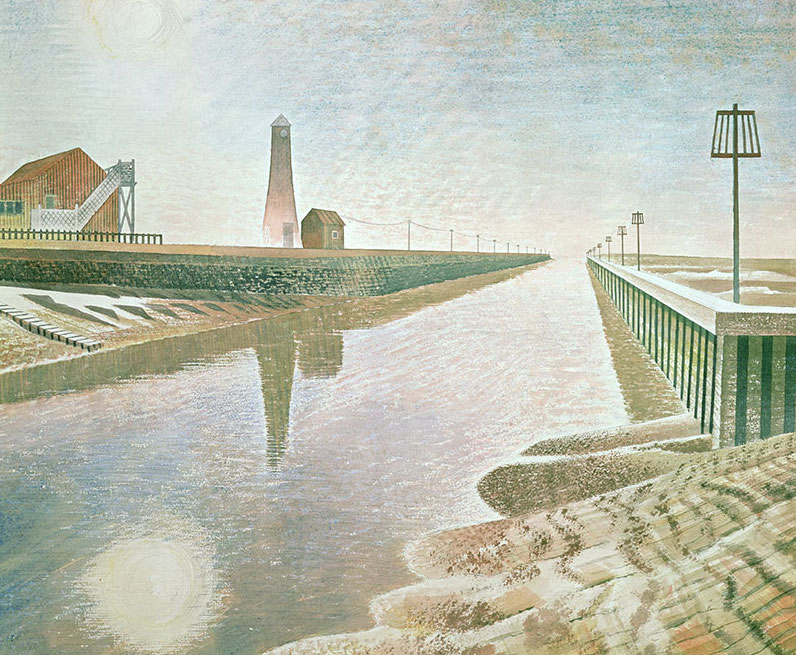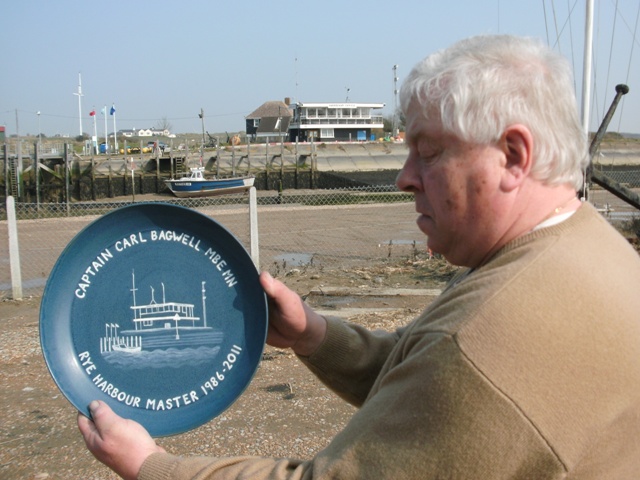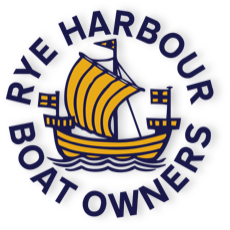Rye has always been a port, It was at one time an island. In Roman times iron production in the area was under the control of the Roman Fleet, Classis Britannica, who exported it from here to the rest of Europe. A senior Cinque Port from the 12th Century, it was the home of the Royal Galleys from 1240, and has been a fishing, shipbuilding and trading port throughout 1000 years. It has also been very involved with pirating, smuggling and coastguard patrols. Nothing much changes !

For new visitors who don’t know
Rye Harbour is the first bit of activity you will see when you approach from sea, new visitors are expected to call in to harbour office before proceeding up the estuary
The flood tide is strong and can make stopping at harbour office difficult for auxiliary yachts so it’s all ways best to time arrival carefully.
Watch out for the traffic signals to alert mariners of shipping movements off the tiny wharf at Rye Harbour, there will be a delay entering or leaving if these require you to stop and wait.
Heading upriver turning to Port at the confuence of the River Brede, known locally as Rock Channel towards Rye there are mooring sites to Starboard, Moon Marine, Sandrock Marine, Rock Channel Marine, and a group of private moorings which are all located together along this narrow stretch of water.
Once you have passed these River Brede Moorings can be seen to Port, it stands out in that part of the river as a busy friendly place with a wide variety of craft based there.
Mooring vessels with fin keels or exposed stern gear has never proved to be a problem with the soft mud gently supporting the boat till the next tide lifts it.
Rye was made a Cinque Port in 1189 under Henry 11, this meant that the port had to provide ships in times of war. Initially Rye had to provide 5 ships within 40 days notice and the town had to support those ships over this period. The Cinque Ports in return were allowed perks like freedom from duties and taxes, the effect was the foundation of Britain’s maritime power.
CAPTAIN CARL BAGWELL MBE MN pictured below was Rye Harbour Master for many years, now recently retired. It is unfortunate that he is last of a diminishing breed hands on dedicated types.

Dredging Strand Quay
by Peter Etherden
This is a cautionary tale and I have cut corners in the telling. Rye’s trawler fleet has been decimated by the European Union over the past few decades and although a new Fishing Quay is finally under construction the part played by the Rye Fishmarket Project in the whole story has been written out of this shortened account which focuses on our failure to dredge Rye’s Strand Quay…something which has been done every few years since time immemorial.
Silt builds up in Rock Channel, the tide moves it gently back and forth twice a day but doesn’t remove it. The silt is washed down into Rock Channel from the Tillingham and Brede Valleys. There are some orchards and some wheat farming in these valleys but mostly its sheep grazing. Romney Marsh is on the Great Sheep Motorway. They come here from the Yorkshire Dales for fattening before being slaughtered. So the silt is marvellous stuff…relatively free of pesticides and herbicides…and it is wicked to waste it.
Once upon a time it was a collective effort to dredge Rock Channel which by custom took place every seven years. Then quangos started to move in…Drainage Boards, Water Boards and the like. These were manned by the same local characters so little appeared to change. The lock keeper in the Lock Keepers Cottage by Brede’s Sluice found a different name at the top of his weekly payslip…and the same went for the Rye Harbour Master. Rock Channel continued to get dredged every seven years. But the quango management was getting more remote and contractor’s lorries were tearing along our local roads shifting soil and shingle here there and everywhere. In the old days river barges used to do the work.
Then in the early 1990s the Environment Agency sent out ambassadors from their regional headquarters in the next county and laid claim to the Rother Waterways, Rye Harbour and all our river banks and drainage ditches. They began by squatting in the Rye Harbour Masters Office. Then they sent an Estates Officer over from headquarters to tidy up the leases. In practice this meant handing out new leases with the Environment Agency’s name at the top and their bank’s standing order on the bottom. Vans began appearing everywhere with the EA logo.
EA put up some more signs
Nobody kicked them out of the Rye Harbour Master’s Office so the EA put up some more signs and started putting up our harbour dues. The moorings fees began to move too…upwards of course. ‘What can I do?’ asked the resident marine engineer who ran our boatyard. ‘The Environment Agency has doubled the cost of my lease. I have no choice. I have to pass it on to the boat owners,’ So money from the users of the rivers and waterways was now going to line the pockets of suits in distant places and pay for their offices and their salaries. Those paying the piper saw very little for their money and had very little say in the tune being played.
When the seven years were up no dredging took place. The Harbour of Rye Advisory Council (HORAC) demanded an explanation. ‘We’ve taken expert advice,’ HORAC were told, ‘and dredging’s only needed every twelve years.’ So that’s alright then. However twelve years came and went, yet still there was no dredging of Rock Channel. HORAC sought further clarification. ‘Aah, yes. Environmental problems. You have the wrong sort of silt.’ Note that ‘us and them’ has now crept into these exchanges. ‘Yes, regrettably your silt has heavy metals in it so we need a licence to dump it.’ Note that it is now ‘our’ fault. ‘But don’t worry we’ll get a licence…but it’ll takes time.’ Note that they have now claimed ownership of the right to determine dredging policy. Two years later there was still no dredging. ‘Aah, yes. There’s been a change of policy. We are now letting waterways return to their natural state.’
I took over as Magazine Editor of the Rye Harbour Boat Owners Association’s magazine as this saga reached its climax. This gave me a seat on RHBOA’s committee which by this stage had appealed to the Royal Yachting Association and got a Commission of Inquiry. In its report the RYA rapped the Environment Agency on the knuckles and told it to open up its accounts and dredge Rock Channel. The EA opened up their accounts but ignored the order to dredge. What to do?
At this stage in the proceedings a new quango appeared on the scene calling itself the Rye Partnership. This was the brainchild of something called the South East England Development Agency. The Rye Partnership started putting up signs. The EA logo was still there but now the EU’s golden stars and the SEEDA logo were also prominently displayed. The Rye Partnership got itself a director, some secretaries and some offices in the centre of town and then cobbled together an advisory board…a sort of Who’s Who of the associations looking after Rye for the past hundred years.
Rye Partnership applied for some EU money through SEEDA and collected a wish list of every project anybody had ever wanted for their grant application. They made a big splash in the local paper about their application but when I studied the proposal there was hardly any new money in it. The Rye Partnership had merely included existing projects and existing funding under their own logos and added in enough for the Rye Partnership itself to get three year’s worth of salaries and office expenses.
There was one other interesting little matter hidden away in the small print. Brussels money was to go, not to Rye or Rye Council, Rye Fishmarket Project or even to the Rye Partnership but would be looked after by Rother District Council who earned themselves several enough money for several Rye Mermaid Street Bridges from the interest on the Rye Fishmarket money as delays on the project escalated.
Matters Reached a Head
Matters had finally reached a head. On RHBOA’s committee I argued that there was only one language the Environment Agency understood and that was money. Now we had the figures we could see that Rye’s small boat-owners were far and away the biggest contributor to the harbour finances. The harbour itself ran at a loss and was subsidised by Rye boat-owners. The pilotage account also ran at a healthy profit, although the Environment Agency had fiddled the books to pretend otherwise and then nicked the money for their own use. I wanted to organise a boycott. Dredge or no harbour dues and mooring fees was to be the line to take.
Have you ever tried to organise a campaign like this? Don’t bother. People have busy lives. Boating is not central to their lives. Your typical Rye Boat-owner pays what he is told, moans about the cost of everything to his wife, regales his dinner guests with tales of his dashing exploits at the mast and then sails out into Rye Bay twice a year just to keep his credibility up. Discrete soundings of RHBOA’s members made it quite clear that the call for a boycott would get very little support. It was hopeless and rather depressing.
With a consumer boycott (e.g. Nestlé’s powder milk or McDonalds), damage to the brand or a sharp reduction in sales hurts the corporate pocket. The more who do it the greater the impact. There is a tipping point somewhere, so the more that pile in the quicker the corporation does its U-turn. But this was a tax boycott – a rather different animal. Numbers are still important for an effective tax boycott but you do not need everyone; just enough people for solidarity to work so you avoid being picked off one at a time.
As we could not get the membership to refuse to pay I suggested that RHBOA’s committee should withhold payment. The money would be paid into some sort of escrow fund and be released once the dredging of Strand Quay was completed. But nobody had the bottle for it. We could see ourselves being dragged off to court, being only too aware that the Environment Agency has no qualms spending taxpayers’ money to retain the best paid lawyers in the country if it sees its power or revenue threatened. What chance would we have?
In the end we did nothing which would no doubt have met with Edmund Burke’s disapproval. In his 1770 pamphlet Thoughts on the Present Discontents, Burke wrote: ‘When bad men combine, the good must associate; else they will fall, one by one, an unpitied sacrifice in a contemptible struggle.’ After a couple of centuries of spin this has now transformed itself into the well-known politician sound-bite that ‘for the triumph of evil, it is only necessary that good men do nothing’. Rock Channel still needs dredging. What to do?
This piece first appeared in the Guy Fawkes Day 2004 draft of England’s Economic Politics for a New Century to be published by the Rye-based publisher Academic Inn Books.
